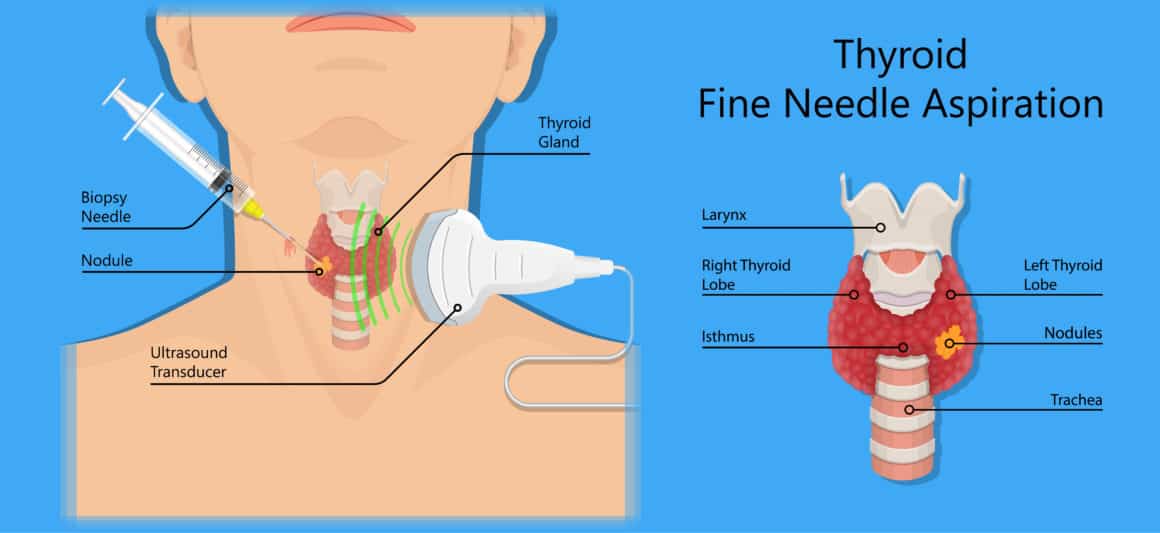When a healthcare provider suspects that a patient has hypothyroidism, they will perform a physical examination and review the patient’s medical history. The provider can then order a group of blood tests, which will determine if the patient’s level of thyroid hormones is within a normal range.
If the patient has the form of hypothyroidism due to Hashimoto’s disease, the healthcare provider may discover a goiter (enlarged thyroid) during the physical examination. Besides hypothyroidism, a goiter can also indicate a lack of iodine in the diet, hyperthyroidism (overactive thyroid), or cancer.
Diagnostic Strategy
The basic strategy healthcare providers use for diagnosing an underactive thyroid is as follows:
- Determine thyroid-stimulating hormone (TSH) levels.
- Check the patient’s level of free thyroxine (free T4), or unbound thyroxine that can affect bodily tissues and functions.
- Check for TPOAb, or TPO antibodies (autoantibodies to the enzyme thyroid peroxidase), and TgAb, or Tg antibodies (autoantibodies to the protein thyroglobulin). Autoantibodies are antibodies produced by the immune system that attack the body, specifically its proteins, such as enzymes. Therefore, these tests can be useful in diagnosing autoimmune hypothyroidism.
- Run other diagnostic tests, which include ultrasounds, thyroid scans, radioactive iodine uptake tests, and fine-needle aspiration biopsies (for patients who have nodules).
Tests
Some of the diagnostic tests used to confirm or rule out hypothyroidism include:
- Blood tests to measure the amount of thyroid-stimulating hormone (TSH) and free T4 (FT4) present in the patient’s blood; when an individual has atrophic thyroiditis, their TSH levels are elevated and free T4 levels are reduced
- Neonatal screening, which measures TSH levels within 48 hours of birth; these screenings are required by law and can indicate whether a newborn has congenital hypothyroidism
- A variety of imaging tests
Blood Tests
Thyroid-stimulating Hormone (TSH) Test
The pituitary gland produces TSH, otherwise known as thyroid-stimulating hormone, thyrotropin, or even thyrotropic hormone. This hormone is responsible for directing the thyroid to produce T3 and T4.
A high TSH level typically means that the individual has hypothyroidism, which means the thyroid is not making an adequate amount of T3 and T4. This lack of thyroid hormone results in the pituitary gland producing and releasing TSH into the bloodstream.
If the results of the TSH test are abnormal, patients will need to have at least one more test to determine why.
Thyroid Antibody Testing
If the results of the TSH test are suggestive of thyroid disease, the doctor may order antibody testing. These tests measure levels of thyroid antibodies (autoantibodies, specifically) an individual has. Determining levels of thyroid antibodies in the system could help with diagnosing an autoimmune thyroid disorder, such as that due to Hashimoto’s disease.
How exactly can antibodies indicate an autoimmune issue, though?
The immune system produces antibodies to fight off “foreign invaders” in the body, such as infections. Sometimes, though, the immune system mistakes part of the body as a foreign invader and attacks this body part accordingly; such cases are known as autoimmune conditions. The antibodies the defective immune system releases in such conditions are known as autoantibodies.
Tests that detect autoantibodies can therefore point to an autoimmune condition. In cases of hypothyroidism, healthcare providers may test for TPOAb and TgAb.
- TPOAb: TPO antibodies, or autoantibodies to thyroid peroxidase, an enzyme
- TgAb: Tg antibodies, or autoantibodies to thyroglobulin, a protein
T4 Test
Patients who have a low T4 level may have hypothyroidism. Sometimes, though, a low level of T4 occurs for another reason and does not indicate a thyroid problem. Such issues that can affect T4 levels include pregnancy, oral contraceptives, or corticosteroids, for example.
Notably, these tests often only test for free T4.
Why, though?
The answer to this question requires a little bit of knowledge about how T4 works. Namely, issues associated with the thyroidâand medications people use to address themâchange the amount of proteins in the blood that attach to T4. Bound T4 attaches to these proteins. Notably, bound T4 does not enter body tissues, but rather remains in reserve until it is needed.
By contrast, free T4âas the name impliesâis not bound; it can therefore enter body tissues. Since bound T4 is not affected by changes in binding-protein levels, many healthcare professionals choose to bypass bound T4 measurements and instead only measure free T4.
T3 Test
In some cases, T4 levels can still be within a normal range despite the patient having hypothyroidism. When a healthcare professional believes that the patient has an underactive thyroid despite the fact their T4 level fell within the normal range, a T3 test may be ordered.
The T3 test might return a high T3 result, for this reason, measuring the patient’s T3 and T4 levels is a useful tool in diagnosing hypothyroidism.
Imaging Tests and Scans
Healthcare providers can use more than blood tests alone to pinpoint hypothyroidism. Imaging tests, for example, are common to not just diagnose a thyroid problem, but also determine its cause.
A trained technician will perform the tests. Then, a doctor specializing in medical imaging, such as a radiologist, will review the images. These specialists will then create a report detailing the findings.
Thyroid Scan
With a thyroid scan, a professional can determine the position, shape and size of the thyroid gland. During this test, patients receive a small amount of radioactive iodine. Why iodine? Because it lets the technician look at the nodules on the thyroid.
Starting a week before their test, patients should avoid foods and medications that are high in iodine, which include:
- kelp,
- iodized salt,
- fish, and
- shellfish.
Ultrasound
An ultrasound oftentimes can locate and allow the healthcare provider to view the patient’s thyroid nodules (lumps in the neck) closely.
Radioactive Iodine Uptake Test (Thyroid Uptake Test)
This test helps check thyroid function to determine what is causing the disorder. This test is referred to as an “uptake test” because the thyroid takes up (aka, uptakes) the iodine in the blood to produce thyroid hormones.
Notably, patients need to avoid foods and medications that are high in iodine for at least a week before their procedure.
Fine-needle Aspiration Biopsy

When a patient has a nodule or a lump on the neck, their healthcare provider may order a fine-needle aspiration biopsy. This test can determine if the nodule is cancerous (malignant) or noncancerous (benign).
What Level of TSH Indicates Hypothyroidism?
Any level above the normal range of 0.4 – 4.5 mU/L can indicate an underactive thyroid when paired with a low T4 level.
Disclaimer: this article does not constitute or replace medical advice. If you have an emergency or a serious medical question, please contact a medical professional or call 911 immediately. To see our full medical disclaimer, visit our Terms of Use page.




